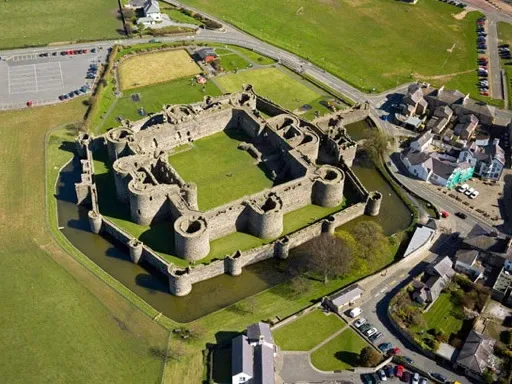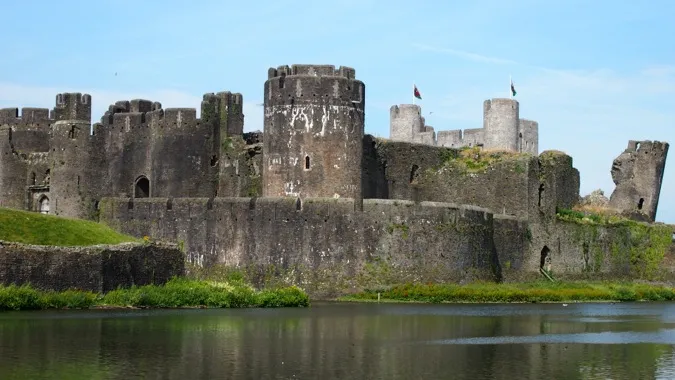Castles are freaking awesome, and a GREAT setting for stories. They’re a symbol of power, authority, wealth, and military prowess in one chonky stone package. It’s no wonder they’re such a mainstay of fantasy worldbuilding!
But so often, people worldbuild castles that don’t make strategic sense. Or they don’t know how to use them in their stories - and yes, I AM looking at Game Of Thrones season 8.
In this post, I’m going to help you create castles that make sense, and have more story possibilities than arrow slits!
1. Put it somewhere strategic
Step 1, put it somewhere strategic. The most common mistake I see is a castle slapped RANDOMLY on a map… with no good reason why it’s there, or what its purpose is!
There are two obvious places to put your castle. The first is on top of a hill. This is easier to defend because running up a hill in full armor is NOT FUN… but also, it's a status symbol. After all, you want your subjects looking up to you at all times. And as a bonus, if things do get bad, you can see the other guys coming from a long way away!
The other common place is in a militarily strategic place like a bridge, a crossroads, or a river crossing - something you want to exert control over. Think about the White Tower on the mouth of the River Thames - which controls river trade and secures the city. Or how about Stirling Castle, which guarded the only passable route between a marsh and a mountain on the way to the north of Scotland.
“He who holds Stirling holds the north”, and yes, this was one of the inspirations for Winterfell in Game of Thrones!

2. Make it defensible
Castles are, by default, designed to be defensible. What that means practically depends on the technology of your world setting, but there are a few things you can expect.
The first is walls. And walls within walls. And.. well, you get the picture.


Of course, there were gates for friendly forces to get through, but these were even more heavily guarded, often with a portcullis and what’s known as a “kill-box” - a strategic area designed to be VERY DANGEROUS if you’re wearing the wrong team’s colours…
And after all that, there are battlements, crenelations, arrow slits, machicolations - which are basically holes to throw things through - and more.
This is just a brief summary of castle defenses - which are very interesting and diverse in different periods - so if you’d like me to do a video going into more detail about castle defenses, let me know in the comments.
- Walls, walls, walls!
- Moats with drawbridges
- Defensible gate houses & kill-boxes
- Battlements, Crenelations, arrow slits, Machicolations
Defensible also means - probably - that your castle can survive a siege. So remember to include a source of fresh water and some large food storage!
- Source of fresh water
- Large food stores
Of course, you’ll also need to have places for your soldiers to sleep and eat, so they’re in tip top condition to guard your castle. And you’ll need to keep their equipment in good condition too, so a weapon smith or armor smith would be helpful. A standard early modern castle had a garrison of around 10-20 men, but your castle might be different.
- Garrison and barracks
- Armory
- Weapon/armor smith or repair shop
3. Make it impressive to show your power
Castles are designed to exude power from Many of those walls would have had drops or moats between them, making it hard to get from one to the other without a draw bridge. Moats also make it harder to use battling rams or tunnel underneath the walls. . Sure that means big high walls and lots of flags. But it also means magnificence. And often an emphasis on history, as a showcase of your owner’s long-established power and stability.
But with all those defensive considerations, space inside a castle is at a premium. The big balancing act is how to make things impressive, but still fit inside your defensive structure. After all, the bigger your castle is, the harder it can be to defend.
You probably don’t want to skimp on the throne room, though. That’s the ultimate seat of power within the castle. You may have this double as a banquet hall - don’t forget the minstrel galleries for your musicians! You might add a reception room for more private meetings. And chances are, whatever the aesthetic, there are constant reminders of who’s in charge. Family trees, emblems, crests and mottos EVERYWHERE - from the tapestries to the napkins to the floor tiles - are a common motif in castles from all eras.
- Throne room, which may double as banquet hall
- Impressive reception room for royalty
- Family trees & crests EVERYWHERE
And, just for fun, why not include some dungeons? These were traditionally either up in towers, or down in the basement. Either way, they should be rather unpleasant and your ruler may include them on their tour… just in case your visitors get any ideas…
- Don’t forget the dungeons
4. Make it homey - as much as you can
While it’s true that castles were primarily military buildings, people did live there - and there are certain things you’ll need for that to make sense!
Your castle owner will probably have a suite of rooms, and their family may also have rooms there. There are probably some guest bedrooms. And of course, you’ll need kitchens and some sort of washing facilities… At least I hope so.
And don’t forget mounts or vehicles! You’ll need stables or garages, preferably inside the castle walls.
It wasn’t uncommon to have small, functional gardens for useful plants - like vegetables, herbs and medicines. Generally these were of limited size, as they took up valuable space.
- Bedrooms for the castle owner
- Bedrooms for the family
- Guest bedrooms
- Bathrooms / washrooms
- Kitchens
- Stables / Garages
- Functional Gardens
And don’t forget to create the mood of your castle.
Do you want bright blue-and-white unicorn tapestries, with vases of fresh flowers set in alcoves of honey colored sand stone?
Or is your castle more about drafts whistling through grey, basalt corridors, dark corners and musty rooms of threadbare black velvet emblazoned with a monstrous gorgon head?
The aesthetics will change the feel of your castle A LOT, so take some time to think about the colors and textures not only of your soft furnishings, but the stone the castle is made of, the lighting, the humidity and the other sensory details. How does this differ in, for example, the servants quarters compared to the king’s?
And how does the location of your castle - that you chose in point 1 - add to the aesthetic? Is it squatting by a polluted river, or rising high above green, fertile hills?
5. And finally… create THE DRAMA
When people think about castles they think about armies, attacks, and sieges. These are really fun to add to your story, and they’re a mainstay of fantasy fiction for a reason.
But Castles are also really great as the seat of internal and interpersonal drama! If you're telling political stories, you have the upstairs versus downstairs, as well as foreign diplomats and guest courtiers. Things over heard, letters diverted, messages misinterpreted… and all those stories come together in a limited space!
Inhabitants may be forced by power dynamics to be nice to those they dislike, at least on the face of it, but spies and intrigue, romance, politics, and character assassination… or REAL assassination! - might all unfold in this limited space. And remember - the traditionally “invisible” people in a castle - the servants, falconers, cooks, grooms and cleaners - see and hear everything, and they’ll add a lot to your story! They might even be your main characters!
There’s a LOT of leeway for great storytelling in a properly worldbuilt castle, and a lot of interesting corridors and corners to explore! Castles make such a fabulous set piece for your worldbuilding that its worth getting them right. They’ll loom large both over your characters, and in your audience’s memory!
If you enjoyed this article, look out for our video on worldbuilding palaces - which are also super cool but very different from castles!
And if you’re looking for more worldbuilding inspiration, go check out the building template on World Anvil - where you can expand your castles to include interactive maps, develop the important rooms, and answer prompts like the ones I’ve been sharing with you in this video, to make them even richer and more interesting!
Become a World
Anvil member

.png)






.png)
